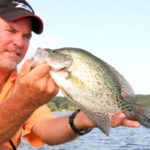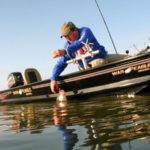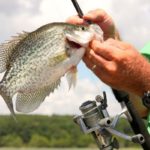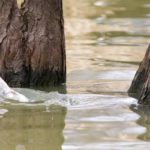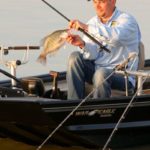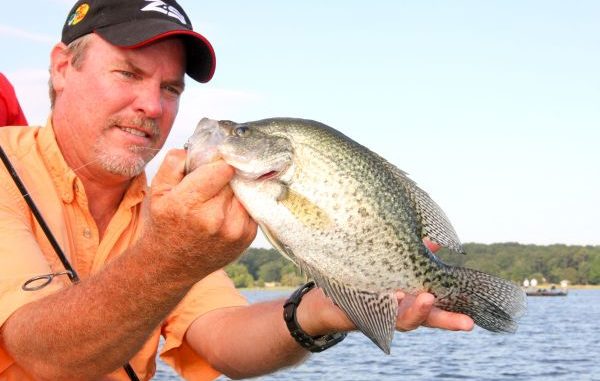
We all wish crappie would stay in their shallow spawning pattern forever, but that’s not how it works. Here’s how to catch D’Arbonne’s white perch during their transition to deep water.
We are constantly bombarded by television and radio commercials commanding us to “ACT NOW BECAUSE THIS OFFER WON’T LAST LONG!”
Although I hate to have to conjure up a picture of such gullibility, I can’t help but see an image in my mind of people running to their phones. I mean, this particular technique has to work or else marketers wouldn’t continue to use it.
Therefore, it is with much annoyance and even more embarrassment that I pass along the following information: The white perch have been up shallow at Lake D’Arbonne, and if you don’t act now, it will be too late because this offer won’t last long.
As a matter of fact, this is a strict, limited-time offer, and you have only two more weeks to take advantage of shallow, target-oriented white perch before they wrap up their spawn and head back out to deeper water.
While the spawn is definitely dwindling down to nothing, veteran Lake D’Arbonne white perch angler Bobby Phillips said he has caught spawning fish in the past up until about the end of the second week in May.
“Usually by then they’re in the post-spawn,” Phillips pointed out. “That means they’re going to be scattering out and heading back toward deeper water.”
However, even when the white perch do move off the shallow cypress trees where they were spawning just days before, they don’t just automatically take a beeline out to the deepest water in the lake.
In fact, David Owen, the angler who purchased Phillips’ famed Honey Hole Tackle Shop in West Monroe several years ago, said fish will hang out for a while on relatively shallow flats somewhere between the shallow spawning water, and the deeper sloughs and creek channels.
“Actually,” Owen began, “white perch stay wherever the shad are, except for when they are up spawning. These fish have been up in as shallow as 1 foot of water, but when they’re done up there they move back out looking for food — and on D’Arbonne this time of year that’s typically on flats from 7 to 10 feet of water right out from where they just spawned.”
So even if you miss the tail end of the white perch spawn, you’ve still got a chance to catch some relatively shallow fish before they move on out to 15 feet and deeper.
Even though the Lake D’Arbonne water temperature was hot enough for the spawn to effectively be over by the first of April, Phillips and Owen will still check to see if there are a few white perch spawning around the cypress trees before heading out to the flats.
“They spawn right on the sides of those trees,” Phillips explained. “I like to ease around each tree and drop a jig down beside it. Some anglers like to stay back a little and throw a cork. Either way will work as long as the fish are still there.”
Owen pointed out that, after fishing cypress trees all morning, two things could become apparent. One is that the white perch could have already abandoned the shallow trees, and the other is discovering which kinds of trees seem to be holding the most fish.
“That will also let you know which trees you need to skip,” Owen said. “I think they spawn better around the more-isolated trees, but you could catch them on clusters, on the trees with big bases or in the clusters.”
If it’s evident that the fish have finished spawning, Owen backs out into 7 to 10 feet of water and searches for fish by drift-fishing out in open water.
It’s not a way that a lot of people like to fish, but Owen has heard it from too many old white perch anglers as they have browsed the baits around his tackle shop: These guys consistently report they catch lots of fish out in open water.
“You might catch some on the stumps and stuff,” Owen noted, “but for the most part it’s been my experience out on those flats that you just kind of drift around. The white perch are following the shad, and you may catch two or three real quick and not catch another one for 30 minutes.
“Add it all up at the end of the day, though, and you’ve got a mess of 20 to 25 fish.”
While a flipping shad or a fish bursting on the surface is worth investigating, Owen said most of the time it’s just a matter of him stumbling across some shad out in the open water.
Often he simply selects a stump or some other object about 100 yards away and systematically fishes his way toward that spot. When he picks up a fish along the way, he will hunker down a while to see if he’s stumbled upon a school of fish.
“I set out a few poles, but I don’t do a typical spider rig with 10 poles out or anything,” Owen said. “I may put out four poles, and then fish with a Road Runner with an ultralight as I slowly drift toward my target.
“For me, fishing the ultralight breaks the monotony of just sitting there watching some jig poles.”
Owen uses his jig poles to help him figure out how deep to fish the Road Runner. If he catches a fish on a pole set at 4 feet, then he casts out his Road Runner, counts it down to 4 feet and reels it back with a slow and steady retrieve.
He also spots baitfish and white perch on his fish finder, but 4 or 5 feet is where he generally starts before he figures out how deep the fish are suspended on any given day.
“The funny thing about fishing the jig poles and the Road Runner at the same time is that white perch will sometimes follow the Road Runner in and then all of a sudden spot all those jigs around my boat,” Owen said. “It’s like they turn off the Road Runner and think to themselves that they’ll just grab one of those baits that aren’t trying to run away from them.”
As far as his most-productive baits go, Owen likes to fish the Blake Lake Tackle No. 120 gray/chartreuse and No. 180 gray/light blue hair jigs or Stinger Shads and Bobby Garland jigs in blue thunder, electric chicken and popsicle (a purple/pink/chartreuse color combination).
“On the Road Runner,” Owen explained, “I just take a white 1/16-ounce head and thread on the blue thunder Bobby Garland color if the water is clear and chartreuse if it’s stained.”
Owens’ favorite Lake D’Arbonne spots to get in on this last-minute shallow and semi-shallow action are Stowe Creek and Bear Creek. Both feature creek channels relatively close to the spawning areas and surrounding flats.
“You can fish white perch like this at any of the creeks in the lake,” Owen said, “but I fish Stowe and Bear because I’ve caught a lot of fish in those creeks over the years — and they both offer a lot of places to fish.
“I figure I can spend my time better fishing two spots that I know well rather than two spots that I don’t.”
Owen lowered his expectations a little bit when he started talking about the Lake D’Arbonne white perch run during May. Since they’ve just come out of the spawn, Owen said he feels like they are as poor as they’re going to be all year long because of the rigors of the spawn.
“Poor and skinny,” he quipped. “A big one this time of year would be 1 1/2 to 1 3/4 pounds because they’re not as healthy now as they were before the spawn.
“The females don’t have any eggs, and the males are worn out. It takes a while for them to build back up.”
At the risk of sounding like a snake-oil salesman, now I must admit that this limited-time offer to catch shallow white perch won’t really be over at the end of May.
Like a limited-time offer that reappears every month, Lake D’Arbonne will offer the same bite all summer long under one condition.
“There will be fish on those flats all summer long, as long as the shad are there,” Owen concluded. “It’s just been my experience that May is the best time to catch them on these shallow flats because they’re just so hungry coming out of the spawn.”
Poor and skinny white perch that are coming out of the spawn looking for something to eat? That makes them just as gullible as a late-night Shopping Channel viewer with his phone in one hand and credit card in the other.
